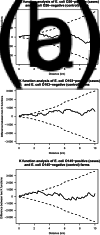Epidemiology of Escherichia coli serogroups O26, O103, O111 and O145 in very young ('bobby') calves in the North Island, New Zealand
- PMID: 28264732
- PMCID: PMC9203324
- DOI: 10.1017/S0950268817000401
Epidemiology of Escherichia coli serogroups O26, O103, O111 and O145 in very young ('bobby') calves in the North Island, New Zealand
Abstract
The prevalence and spatial distribution of Escherichia coli serogroups O26, O103, O111 and O145 in calves 70% similarity) using pulsed field gel electrophoresis. Mapping of the farms showed the presence of farms positive for O26, O103 and O145 in three important dairy producing regions of the North Island. Calves positive for O103 were more likely to be positive for O26 and vice versa (P = 0·04). Similarly, calves positive for O145 were more likely to be positive for O103 and vice versa (P = 0·03). This study demonstrates that non-O157 E. coli serogroups of public health and economic importance containing clinically relevant virulence factors are present in calves in the North Island of New Zealand.
Keywords: Calves; New Zealand; non-O157 STEC.
Conflict of interest statement
None.
Figures



Similar articles
-
Prevalence and Epidemiology of Non-O157 Escherichia coli Serogroups O26, O103, O111, and O145 and Shiga Toxin Gene Carriage in Scottish Cattle, 2014-2015.Appl Environ Microbiol. 2021 Apr 27;87(10):e03142-20. doi: 10.1128/AEM.03142-20. Print 2021 Apr 27. Appl Environ Microbiol. 2021. PMID: 33712425 Free PMC article.
-
Prevalence and virulence factors of Escherichia coli serogroups O26, O103, O111, and O145 shed by cattle in Scotland.Appl Environ Microbiol. 2006 Jan;72(1):653-9. doi: 10.1128/AEM.72.1.653-659.2006. Appl Environ Microbiol. 2006. PMID: 16391103 Free PMC article.
-
Temporal shedding patterns and virulence factors of Escherichia coli serogroups O26, O103, O111, O145, and O157 in a cohort of beef calves and their dams.Appl Environ Microbiol. 2004 Mar;70(3):1708-16. doi: 10.1128/AEM.70.3.1708-1716.2004. Appl Environ Microbiol. 2004. PMID: 15006796 Free PMC article.
-
Prevalence and pathogenicity of Shiga toxin-producing Escherichia coli in beef cattle and their products.J Anim Sci. 2007 Mar;85(13 Suppl):E63-72. doi: 10.2527/jas.2006-421. Epub 2006 Oct 23. J Anim Sci. 2007. PMID: 17060419 Review.
-
Detection, Prevalence, and Pathogenicity of Non-O157 Shiga Toxin-Producing Escherichia coli from Cattle Hides and Carcasses.Foodborne Pathog Dis. 2018 Mar;15(3):119-131. doi: 10.1089/fpd.2017.2401. Foodborne Pathog Dis. 2018. PMID: 29638166 Review.
Cited by
-
Prevalence and Epidemiology of Non-O157 Escherichia coli Serogroups O26, O103, O111, and O145 and Shiga Toxin Gene Carriage in Scottish Cattle, 2014-2015.Appl Environ Microbiol. 2021 Apr 27;87(10):e03142-20. doi: 10.1128/AEM.03142-20. Print 2021 Apr 27. Appl Environ Microbiol. 2021. PMID: 33712425 Free PMC article.
-
Shiga toxin-producing Escherichia coli illness in Aotearoa | New Zealand, 2016-2022: epidemiological, genomic and traditional typing analyses provide insight into a significant endemic disease while highlighting knowledge gaps.Front Microbiol. 2025 Jul 2;16:1605469. doi: 10.3389/fmicb.2025.1605469. eCollection 2025. Front Microbiol. 2025. PMID: 40673153 Free PMC article.
References
-
- Bettelheim KA. The non-O157 Shiga-toxigenic (Verocytotoxigenic) Escherichia coli; under-rated pathogens. Critical Reviews in Microbiology 2007; 33: 67–87. - PubMed
-
- Karmali MA, Gannon V, Sargeant JM. Verocytotoxin-producing Escherichia coli (VTEC). Veterinary Microbiology 2010; 140: 360–370. - PubMed
-
- World Health Organization. Zoonotic non-O157 Shiga toxin-producing Escherichia coli (STEC). Report of a WHO Scientific Working Group meeting (http://whqlibdoc.who.int/hq/1998/WHO_CSR_APH_98.8.pdf). 1998.
-
- Mainil JG, Daube G. Verotoxigenic Escherichia coli from animals, humans and foods: who's who? Journal of Applied Microbiology 2005; 98: 1332–1344. - PubMed
-
- EFSA Panel on Biological Hazards. Scientific opinion on VTEC-seropathotype and scientific criteria regarding pathogenicity assessment. European Food Safety Authority Journal 2013; 11: 3138.
MeSH terms
Substances
LinkOut - more resources
Full Text Sources
Other Literature Sources
Medical

